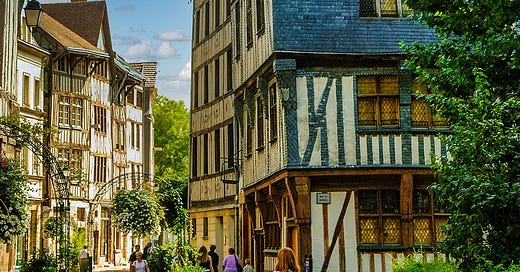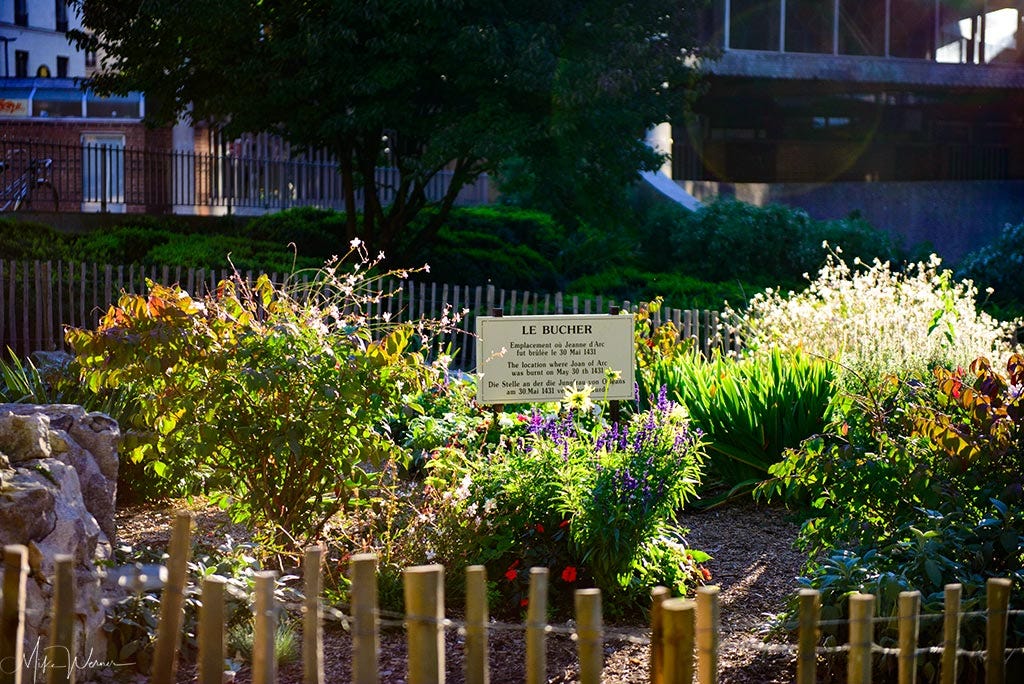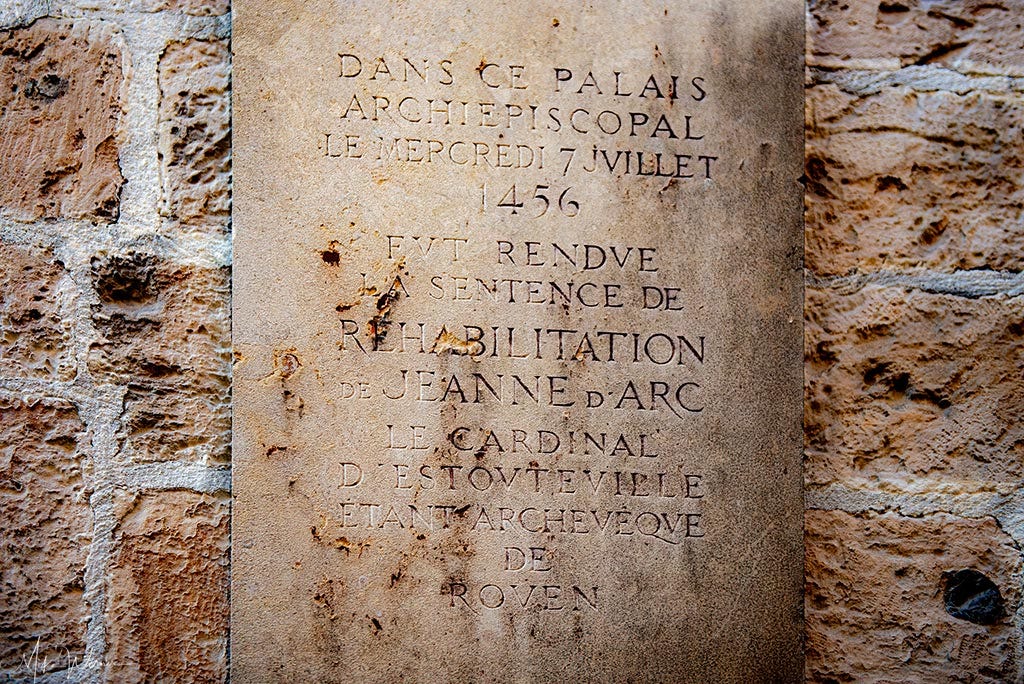Rouen, a city rich in history and culture, is located in the Normandy region of northern France, situated along the banks of the Seine River. Its history dates back to Roman times, and over the centuries, it has played a significant role in both French and European history. Notably, it was a prosperous medieval city, a fact evident in its architecture and urban layout, which includes a well-preserved old town.
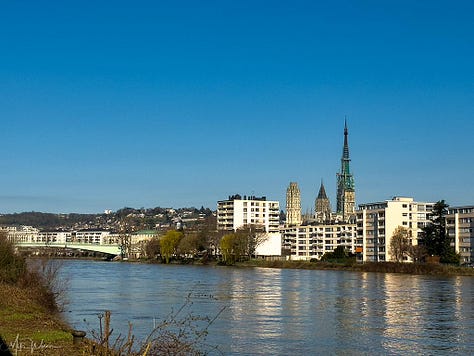


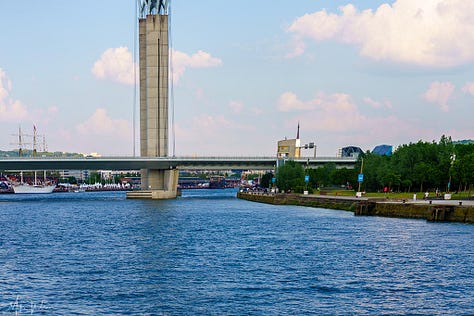

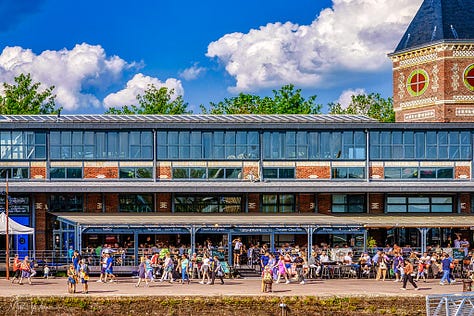
The Seine River, which gracefully flows through Rouen, plays a central role in the city's charm and functionality. Several bridges span the river, connecting the left bank to the right bank, facilitating easy movement and offering picturesque views of the historic cityscape. These bridges not only serve as critical transportation links but also add to the scenic beauty of Rouen, making them popular spots for both locals and tourists.
Alongside its bridges, Rouen features a bustling harbor that accommodates medium-sized cargo ships, reflecting its importance as a commercial port in the Normandy region. The harbor’s activity contributes significantly to the local economy, supporting trade and logistics.
Furthermore, Rouen is a popular stop for river cruise ships, which bring a steady flow of visitors to the city. These cruises offer a unique perspective on Rouen’s architectural and historical treasures, as seen from the vantage point of the Seine. The presence of these ships highlights Rouen's appeal as a tourist destination and its strategic importance along one of Europe's major rivers.
NOTE: This is Part 1 or 5 articles on the introduction of the city of Rouen.
Click here to read Part 2.
Click here to read Part 3.
Click here to read Part 4.
Click here to read Part 5.You can subscribe to our free newsletter and receive updates directly in your inbox.
Joan of Arc
Joan of Arc, also known as Jeanne d'Arc, was a peasant girl born around 1412 in Domrémy, a small village in northeastern France. She became a national heroine of France and a saint of the Catholic Church for her role during the Lancastrian phase of the Hundred Years' War, a series of conflicts between England and France. Claiming to have received visions from saints instructing her to support Charles VII and recover France from English domination late in the Hundred Years' War, Joan was an extraordinary figure in that she was a young, religious woman who took a direct role in military strategy and combat.
In 1429, Joan led French forces to lift the siege of Orléans, a pivotal moment that led to Charles VII's coronation as the King of France. Her success at Orléans made her famous almost overnight, symbolizing hope for France’s ultimate victory. However, her fortunes changed when she was captured by Burgundian forces, allied with the English, near Compiègne in 1430. Subsequently, she was handed over to the English, who orchestrated a trial against her at Rouen for charges including heresy and witchcraft.
The text read “In this archiepiscopal palace on Tuesday, May 29, 1431, the session of the trial of Joan of Arc was held, where she was summoned to appear the following day at the old market“
Rouen, the historical capital of Normandy, played a crucial role in Joan's life, albeit a tragic one. It was here, in 1431, that she was tried and convicted in a politically motivated and notoriously biased trial.
She was held prisoner in the tower of the Rouen Castle during her trial. The trial itself was overseen by Pierre Cauchon, a bishop loyal to the English, who sought to delegitimize Joan's divine guidance claims, thereby undermining Charles VII's legitimacy.
Despite her assertive defense, Joan was found guilty and burned at the stake in Rouen's Old Market Square on May 30, 1431, at just nineteen years old.
Her death marked an important moment in the Hundred Years' War, symbolizing the brutal lengths to which the conflict had reached. However, her martyrdom only increased her legend.
The text above reads “In this archiepiscopal palace on Wednesday, July 7, 1456, the sentence of rehabilitation of Joan of Arc was pronounced, with Cardinal d'Estouteville being the Archbishop of Rouen.“
In 1456, a posthumous retrial ordered by Charles VII cleared her of all charges, rehabilitating her reputation. Joan of Arc was canonized as a saint in 1920, immortalizing her as a symbol of French unity and nationalism. Rouen, meanwhile, remains a place of pilgrimage for those honoring her memory, with several monuments and historical sites dedicated to her life and legacy. The city has embraced its association with Joan of Arc, maintaining historical archives and conducting various cultural events that reflect on her life and the medieval period.
Vikings
The Viking influence on Rouen and the surrounding Normandy region is a fascinating and significant chapter in the city's history. This influence began in the 9th century, a period marked by the arrival of Norsemen, commonly known as Vikings, from what is today Scandinavia. These seafaring warriors were initially raiders and plunderers but eventually became settlers and traders, profoundly impacting the region's cultural, political, and social landscapes.
One of the most pivotal moments in this history was the establishment of the Duchy of Normandy in the early 10th century. This was a result of the Treaty of Saint-Clair-sur-Epte in 911, where the Frankish king Charles the Simple granted the Viking leader Rollo a significant portion of land in northern France. In exchange, Rollo pledged fealty to the king and agreed to defend the territory against other Viking raids. This area, which included Rouen, became known as Normandy, derived from "Northmen" or "Norsemen," referring to its Viking founders.
Rollo, who is often considered the first Duke of Normandy, established Rouen as his capital. He and his successors played a crucial role in developing the city and the duchy. The Norse settlers intermarried with the local Frankish population, leading to a fusion of Norse and Frankish cultures. This blend is reflected in the region's language, customs, and legal systems, which evolved uniquely compared to other parts of France.
The influence of the Vikings in Rouen is not just historical but also left tangible marks. For example, the layout of the city, including some of its streets and buildings, can be traced back to the Viking era. The Vikings were skilled in urban planning and construction, contributing to the development of Rouen as a significant medieval port and commercial center.
Moreover, many place names in Normandy, including Rouen, bear traces of Norse origins. The impact of Viking culture is also evident in the region's art, storytelling, and even in some elements of Norman architecture, which show influences from Norse artistic styles.
The legacy of the Vikings in Normandy also had far-reaching consequences beyond the region. The Normans, as the descendants of the Norse settlers became known, played a significant role in European history. The most famous example is the Norman Conquest of England in 1066, led by William the Conqueror, the Duke of Normandy. This event, which had a profound impact on the history of England and Europe, originated from the same Norse culture that had shaped Rouen and Normandy centuries earlier.
NOTE: This is Part 1 or 5 articles on the introduction of the city of Rouen.
Click here to read Part 2.
Click here to read Part 3.
Click here to read Part 4.
Click here to read Part 5.You can subscribe to our free newsletter and receive updates directly in your inbox.

